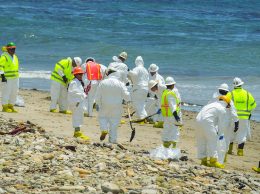$114M slated to fuel Santa Maria Energy operations
IN THIS ARTICLE
- Central Coast Topic
- Stephen Nellis Author
By Stephen Nellis Friday, January 10th, 2014
Santa Maria Energy has disclosed plans to pump up to $114 million into Santa Barbara County this year as it pursues its $1.2 billion in oil reserves and more than 7,700 potential drilling locations.
Santa Maria Energy’s contentious project to drill 136 new oil wells in North Santa Barbara County received approval from the Santa Barbara County Board of Supervisors late last year. The Supervisors imposed strict levies on the project’s carbon emissions, essentially implementing a 10,000-ton-per-year cap and requiring the company to buy carbon credits if it goes over that limit.
Weeks later, Santa Maria Energy announced plans to become what will likely be the first publicly traded non-financial company to be headquartered in Santa Maria in years. The company said it would merge with a so-called blank-check firm called Hyde Park Acquisition Corp. II and raise at least $40 million and possibly more than $70 million. That capital would come in addition to the $50 million that Santa Maria Energy already raised from Kayne Anderson Capital Advisors, an energy-focused private equity firm.
Most of Santa Maria Energy’s assets are tied up in land at three locations in Orcutt, Casmalia and just south of Santa Maria. In securities filings, the company has said that it also will likely need to raise extra cash through the private-equity markets to reach its ambitious capital goals for the next year, making the exact ownership profile of the future company hard to determine.
“Santa Maria Energy’s initial estimate for its capital budget in 2014 is $114.3 million,” the company — which is barred from talking to the media during the deal — said in its regulatory filings. “Santa Maria Energy expects to be able to raise the capital required by the budget through the merger, the private-equity financing or other sales of equity, debt borrowings and cash provided by operations.”
At present, Santa Maria Energy’s operations are relatively small. It has 27 employees. In 2012, the company generated $14.6 million in revenue from its existing oil operations, notching a loss of $3.7 million. But the company’s disclosures about its reserves suggest that Santa Maria’s current drilling project could be the start of much larger operations in coming years.
In the first detailed disclosures about Santa Maria Energy’s reserves, the company said it believes it has about 48 million barrels of oil in reserves, worth $1.2 billion when using industry-standard discounting techniques. Only about 15.7 million barrels of that oil are what the company considers “proved” reserves, but that figure is still nearly double what the company believed it was sitting on at the end of 2012, according to company filings.
Santa Maria Energy’s most recent permit process involved drilling near Orcutt in a rock formation known as the diatomite. But the company also has acreage in the Monterey Shale formation near Orcutt, as well as thousands of potential drilling sites northwest of Casmalia and in the Santa Maria Valley. Overall the company has 15,692 net acres under lease. Santa Maria Energy’s executives believe the firm has 7,753 potential drilling locations for the future.
Santa Barbara County Supervisor Peter Adam, whose district will see most of the activity, lauded Santa Maria Energy’s planned spending. “I’d certainly like to see some more of it,” Adam told the Business Times.
For all the sound and fury over the 10,000-ton-per-year carbon cap imposed by County Supervisors, the measure only elicited a few lines in the 225,599 words of disclosures that Santa Maria Energy made to investors: “Santa Barbara County has applied an interim threshold of 10,000 [Metric Tons of Carbon]. This will require Santa Maria Energy to purchase offsets in addition to those required by the state’s cap and trade program to fulfill its requirements to Santa Barbara County under CEQA. This will result in additional operating costs and may adversely affect operating results,” the company wrote.
Cap may not matter
Linda Krop, chief counsel of the Environmental Defense Counsel in Santa Barbara, which opposed the group’s permit application, was not surprised. She said that Plains Exploration Co. had agreed to buy credits to offset every single ton of carbon in a deal to expand its drilling rights in exchange for eventually pulling its drilling platform out of the Santa Barbara Channel. The deal was ultimately scuttled by the State Lands Commission, but the carbon requirements were never in serious dispute because they simply didn’t cut that far into profits.
“The county did not restrict [Santa Maria Energy’s] operations and did not restrict emissions. All the county did was treat this like any other impact and say you have to mitigate,” Krop told the Business Times. She said her group has urged the county to require all carbon emissions for oil projects to be offset by carbon credit purchases and wants the county to adopt a formal carbon policy rather than operate on a case-by-case basis.
Adam, the Supervisor, wants a set carbon policy also, calling the current system “arbitrary and capricious.” But he wants that policy to not regulate beyond existing state carbon limits. “I want everybody to be able to go recover their assets. To that extent, I would love for everybody to be able to put in their permit applications and have them dealt with in a timely fashion, with some added certainty,” Adam said.
Because Santa Maria Energy’s leaders can’t talk publicly while its going-public deal is in the works, it is unclear why the firm’s proved reserves nearly doubled in less than a year. But there’s a good chance it involves improved oil recovery technologies. Santa Maria Energy has specifically said that it has no plans to use hydraulic fracturing, or “fracking.” But most of its reserves will be tapped with so-called “unconventional” techniques, such as using steam to coax oil from the earth.
“The story of oil production in California for over 100 years has been one of technology,” said Tupper Hull, a spokesman for the Western States Petroleum Association in Sacramento. “There are fields in Kern County that have been producing for far longer than anyone anticipated. I think there’s a lot of optimism and confidence that California will continue to be a significant oil producer well into the future.”
Related Articles
 Friday, September 16th, 2022
Friday, September 16th, 2022
Medical school trains the next generation of physician assistants in Santa Maria
 Friday, September 2nd, 2022
Friday, September 2nd, 2022










